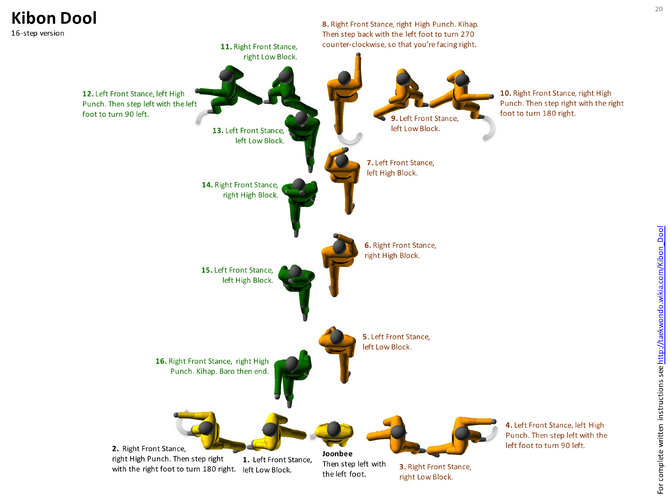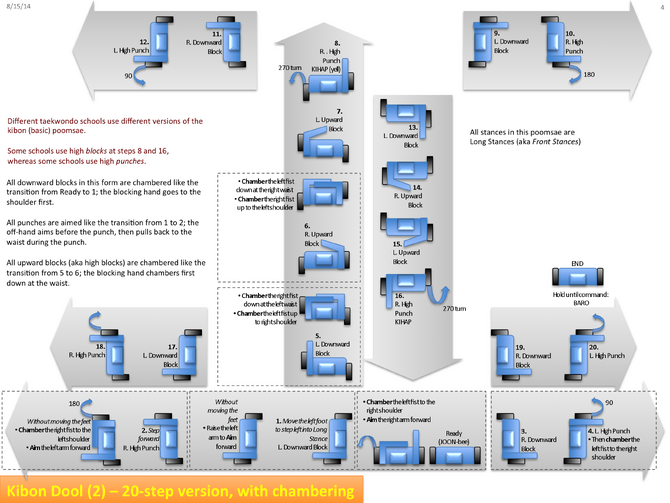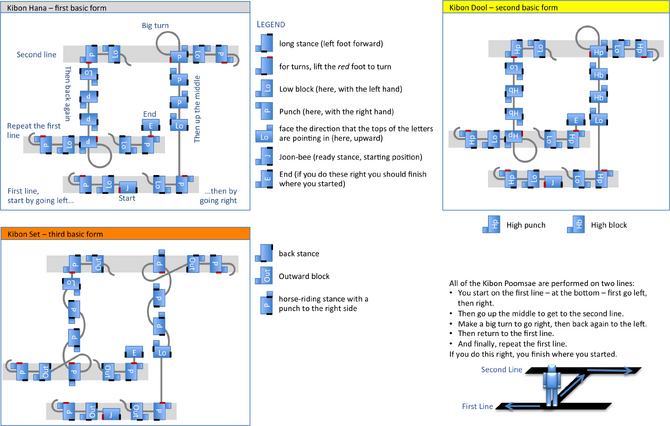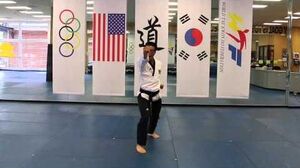
9gup Yellow Belt Kibon Dool
The term Kibon Dool means "basic #2" - dool is the number 2 in the traditional Korean numbering system. Kibon Dool is a simple, basic form (poomsae) often taught to introductory students at some taekwonwo schools after Kibon Hana, especially in Kukkiwon/WTF-style taekwondo. Unlike the standard Kukkiwon/WTF-forms, the Kibon forms are not standardized: different schools use different forms. Often, the forms are based on the Tang Soo Do forms Kicho Hyeong Il Bu, Ee Bu, and Sam Bu.
The following diagram shows a top-down view of a typical 16-step version of Kibon Hana taught at some schools. Your school's form may be different.
- All of the stances in this version of the form are Front Stances (aka Long Stances).
- All of the blocks are Low Blocks (aka Downward Blocks) and High Blocks (aka Upward Blocks).
- All of the punches are high, nose-height punches.
The "lines" of the form are an I-shape. You start by moving to the left, then back to the right. Then up the middle. Then to the right, and back to the left. Then back down the middle.
Chambering[]
As with most taekwondo forms, an essential part of the form is how to chamber for each movement. In other words, before you block, where do you put your hands in preparation for the block? Before you punch, where do you put your hands in preparation for the punch?
The following diagram is a 20-step version of Kibon Dool where the first line is repeated at the end, adding an extra 4 steps to the form. This version of the diagram also indicates the chambering used in the form.
Written Instructions[]
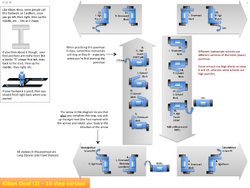
This form is just like Kibon Hana, except that the middle-height punches are replaced with face-height punches, and some of the Low Blocks are replaced with High Blocks.
- Note that at some schools, they perform High Blocks at steps 8 and 16 instead of High Punches. One doesn't normally Kihap (yell) for blocks though (only for strikes, punches, and kicks) so it would be unusual to Kihap at steps 8 and 16 if you're doing the High Blocks version of the form.
Start in the "Joonbee" Ready Stance.
The First Line[]
First Going Left (Da 1)...
- Chamber the left fist to the right shoulder. Point the right fist straight out in front of you.
- 1. Step left with the left foot to turn left 90 degrees into a Front Stance (aka Long Stance) with the left foot forward. At the same time, Low Block (aka Downward Block) with the left arm, while pulling the right fist back to your right hip (palm-up).
- Then aim for the upcoming punch by raising the left fist straight out in front of you.
- 2. Step forward with the right foot into a Right Front Stance. Simultaneously face-height High Punch with the right fist; of course, at the same time pull your left fist back to your left hip (palm-up, of course).
Then Going Right (Ra 1)...
- Chamber for the block by bringing the right fist to your left shoulder.
- 3. Step back and to the left with your right foot so that it's way behind you and to the left, then pivot on the left foot 180 degrees to the right so that now you're in a Front Stance with the right foot forward. Simultaneously Low Block with your right arm.
- Aim for the upcoming punch by raising the right fist straight out in front of you.
- 4. Step forward with the left foot into a Left Front Stance. Left High Punch.
- Chamber the left fist to the right shoulder.
Transition to the Second Line[]
- 5. Step left with the left foot to turn 90 degrees left into a Left Front Stance. Left Low Block.
- At the conclusion of your Low Block, your right fist should of course be at your right hip, palm up. Chamber for the upcoming block by moving your right fist to the left hip. In other words, your right fist just travels left along your belt. Chamber the left fist to the right shoulder.
- 6. Step forward with the right foot into a Right Front Stance. Right High Block (aka Upward Block).
- Chamber the left fist to the right hip. Chamber the right fist to the left shoulder.
- 7. Step forward with the left foot into a Left Front Stance. Left High Block.
- Aim the left fist straight out in front of you.
- 8. Step forward with the right foot into a Right Front Stance. Right High Punch. Kihap (yell).
- At some schools, step 8 is a Right High Block rather than a Right High Punch.
- Here's another one of those tricky turns. You're going to turn right 90 degrees, but you're going to do it by turning left 270 degrees. Chamber the left fist to the right shoulder, point the right fist straight out in front of you.
The Second Line[]
First Going Right (Ra 2)...
- 9. With the left foot, step back and way to the right. Then pivot left on the right foot so that you wind up turning left 270 degrees into a Left Front Stance. Left Low Block.
- Aim the left fist straight out in front of you.
- 10. Step forward with the right foot into a Right Front Stance. Right High Punch.
- Chamber the right fist to the left shoulder.
Then Going Left (Da 2)...
- 11. Step back and to the left with the right foot, then pivot 180 degrees to the right on the left foot into a Right Front Stance. Right Low Block.
- Aim the right fist straight out in front of you.
- 12. Step forward with the left foot into a Left Front Stance. Left High Punch.
Transition Back to the First Line[]
- 13. Step left with the left foot to turn 90 degrees left into a Left Front Stance. Left Low Block.
- Chamber the right fist to the left hip.
- 14 Step forward with the right foot into a Right Front Stance. Right High Block.
- 15. Step forward with the left foot into a Left Front Stance. Left High Block.
- 16. Step forward with the right foot into a Right Front Stance. Right Punch (or in some schools, a Right High Block). Kihap (yell).
- If you're doing the 16-step version of this form you stop here, until the instructor says Baro, then you lift up your left foot to turn 180 degrees to the left, back into the Joonbee Ready Stance.
- But if you're doing the 20-step version, you do another one of those tricky 270-degree turns now. Chamber the left fist to the right shoulder.
Repeating the First Line[]
First Going Left (Da 1)...
- 17. With the left foot, step back and way to the right. Then pivot left on the right foot so that you wind up turning left 270 degrees into a Left Front Stance. Left Low Block.
- Aim for the upcoming punch by raising the left fist straight out in front of you.
- 18. Step forward with the right foot into a Front Stance. Right High Punch.
Then Going Right (Ra 1)...
- Chamber for the upcoming block by bringing the right fist to your left shoulder.
- 19. Step back and to the left with your right foot so that it's way behind you and to the left, then pivot on the left foot 180 degrees to the right so that now you're in a Right Front Stance. Right Low Block.
- Aim for the upcoming punch by raising the right fist straight out in front of you.
- 20. Step forward with the left foot into another Front Stance. Left High Punch.
- Wait until the instructor says Baro, then bring the left foot back to turn left 90 degrees, so that you're facing the original starting position, a Joonbee Ready Stance.
- If you did everything right, you wound up exactly where you started, on the same spot, facing in the same direction.
Other Kibon Forms[]
The three forms frequently found in the Kibon series are:
- Kibon Hana - basic form #1
- Kibon Dool - basic form #2
- Kibon Set - basic form #3
These correspond to the three kicho hyung found in Traditional Taekwondo. The following diagram is a summary of all three forms.
See WTF beginner forms for additional information.
